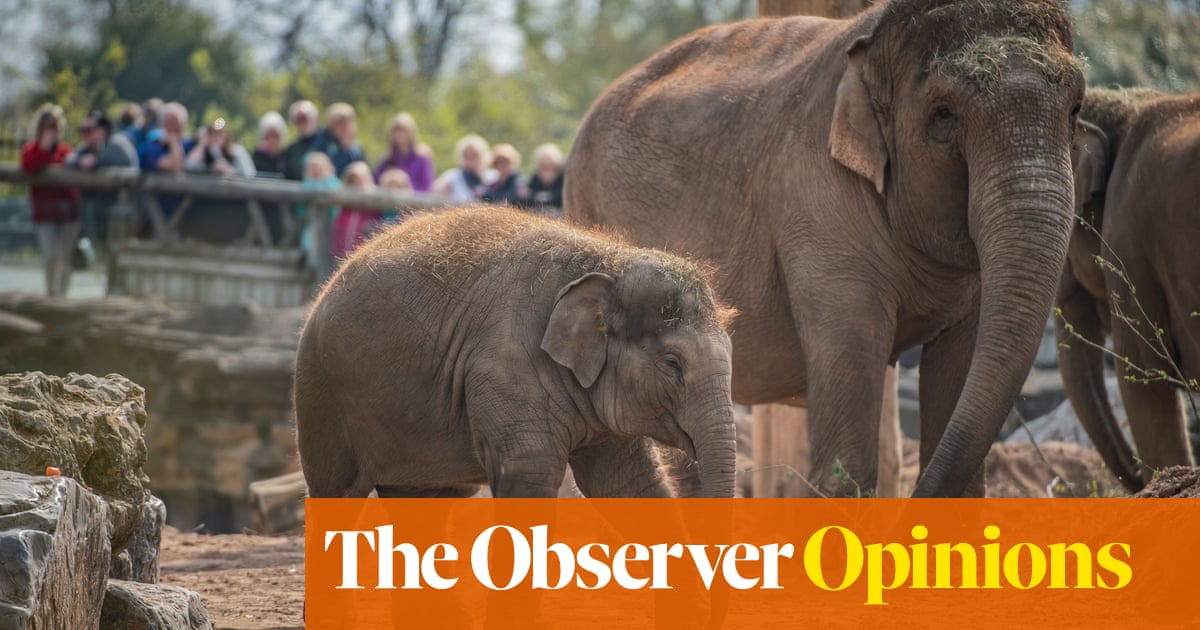Zoos are not educational as they create false information about the animals they keep captive.

E
Every afternoon at the London Zoo, from the 1970s and earlier, there would be a table set up for the chimpanzees. This table would have cups, saucers, and a teapot, and it was expected to be an amusing event where the chimps would throw dishes at each other and climb on chairs. However, there was a complication that arose early on.
Chimpanzees have a remarkable ability to master tools. They were able to quickly grasp the correct use of the pot and would calmly sit at the table, partaking in afternoon tea.
According to Frans de Waal’s book, Are We Smart Enough to Know How Smart Animals Are?, the public tea parties posed a threat to human egos, prompting action. The apes were then taught to spill tea, throw food, and drink from the teapot’s spout. Being quick learners, they excelled and even added a comedic touch, putting cups in the teapot when the keeper wasn’t looking. This trick was successful, as newspapers at the time reported the animals behaving with their usual playful manner.
During the initial days, the chimps’ actions were unsettling. Their demonstration of skill not only questioned the egos of those watching, but also challenged the very concept of a zoo. If animals were able to think or feel, the zoo’s enclosure and confinement may appear more ominous. Instead of being seen as harmless entertainment, it could be perceived as a cruel form of imprisonment. Zoos had a vested interest in teaching visitors the opposite idea. They became places of fiction, acting as anti-educators. The truth about the animals in captivity could not be fully revealed.
It is unusual that modern zoos often see themselves as educational institutions, as stated in their mission and as a key justification. Recently, Joanna Lumley made a plea to release 50 captive elephants in the UK, citing physical and psychological harm. However, the CEO of Chester Zoo rejected her claims as being “outdated”. He believes that zoos today are more advanced and differ greatly from how they were 50 years ago, playing a vital role in conservation efforts.
Is he correct? It should be noted that he does not state that elephants do not experience suffering in zoos. It is difficult to deny that these establishments still cause distress to animals, especially those that are large and highly intelligent. It is clear that elephants, big cats, and primates do not find captivity enjoyable.
Even the most open and aesthetically pleasing zoo habitats cannot compare to the vast diversity of life found in nature. Animals exhibit natural behaviors such as pacing, grooming, and experiencing mortality. It is alarming to note that a significant portion of zoo animals are prescribed psychoactive medication. A study conducted in 2000 revealed that nearly half of North American zoos administered Valium to their gorillas to ease their boredom and lack of stimulation.
Many people defend modern zoos by making an unspoken deal. They acknowledge that the animals may not be happy, but argue that their existence serves a greater purpose: conservation efforts and educating the public. By sacrificing a few captive animals, we can save many more in their natural habitats and possibly inspire future conservationists. However, in order for this to happen, people must first see the animals in person. It seems that humans, like fickle gods of old, demand a sacrifice before showing compassion and empathy.
However, this deal based on cruel practices does not make sense. Running zoos is a costly endeavor and they do not generate significant profits for charitable purposes. According to the Born Free Foundation, only 4.2% of profits from the largest charitable zoos in the UK are used for field conservation. Even those zoos that donate larger amounts do not provide a convincing explanation for why keeping animals in cages is necessary in order to save others. Captive breeding for release into the wild is often unsuccessful, especially when done far away from their natural habitats. Zoos originated from menageries, which were collections of exotic animals owned by the wealthy and powerful. There is no historical or logical connection between zoos and conservation. Furthermore, zoos fall short in their claims to be educational facilities. For decades, animal research has consistently shown that humans are not as unique as we believe ourselves to be among the many species on this planet.
The discovery of “uniquely human” abilities such as cooperation, theory of mind, tool use, planning, perceptions of time, grief, fear, empathy, and friendship has expanded to include a wider range of species.
Zoos have a responsibility to convey the opposite message. When one becomes aware that intelligent and sensitive animals are confined behind bars, visiting zoos becomes an activity only enjoyed by individuals with sociopathic tendencies. Therefore, upon entering the gates, there must be a deliberate process of unlearning these realities.
The zoo is responsible for creating an illusion for visitors that the animals, who may be seen pacing or twitching, are content and living as they would in their natural habitat. This often requires visitors to overlook the fact that the artificial jungle behind the animals is a mere substitute for the real thing. As a result, visitors tend to adopt Victorian beliefs that animals are mechanical and lack the ability to experience emotions.
Can zoos motivate individuals to become conservationists? It is doubtful. Conservation is based on the belief that we do not have inherent control over other species or the authority to exploit them for our own purposes. However, zoos operate on the contrary notion that humans are consumers and animals are meant to be consumed.
John Berger stated that adults bring children to the zoo to introduce them to the real versions of their stuffed animal replicas. This is where they discover that animals are not equal beings, but rather objects.
Source: theguardian.com


